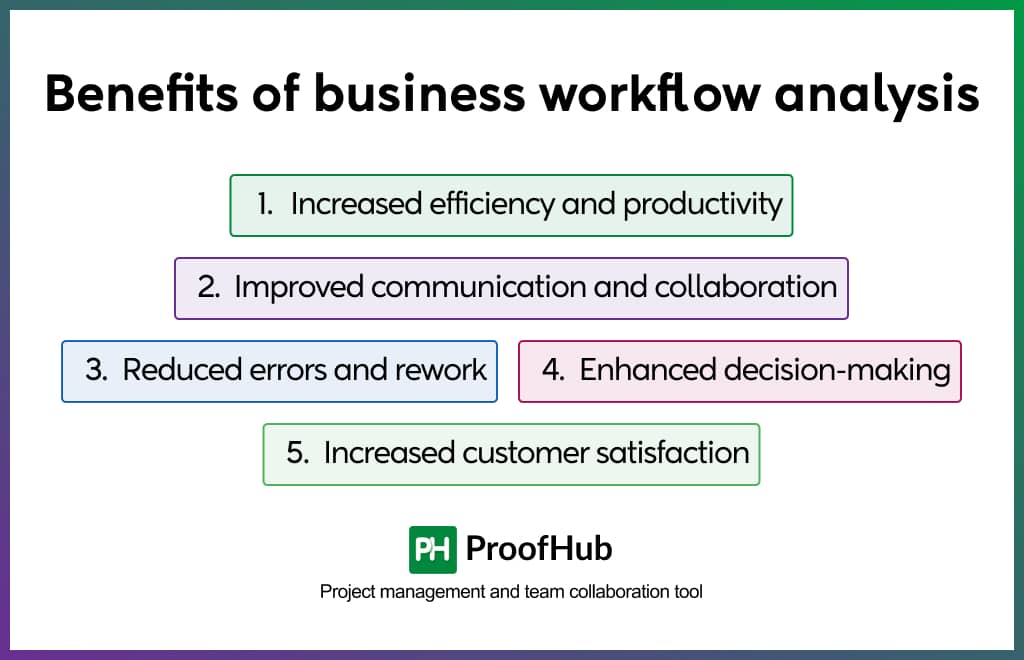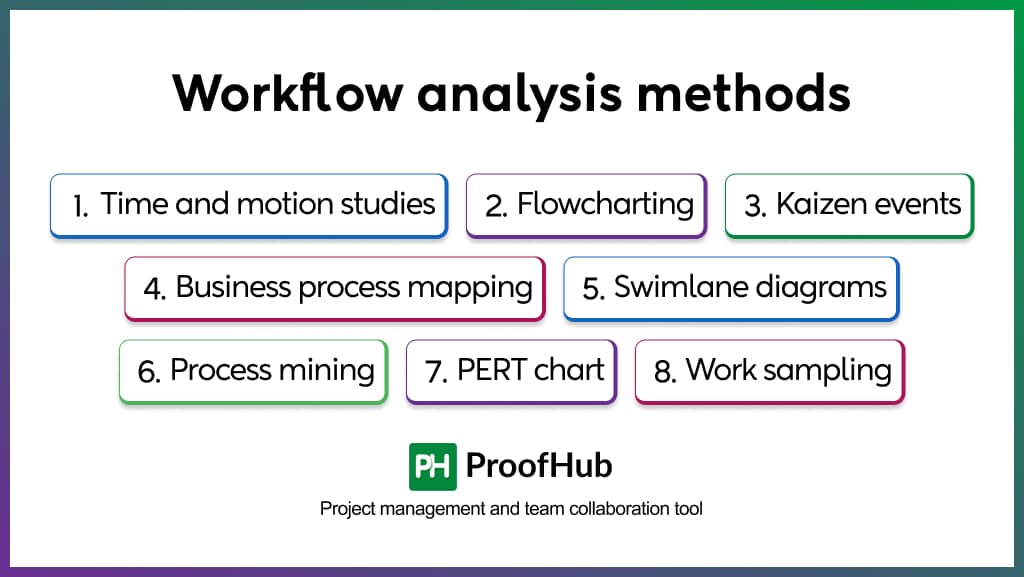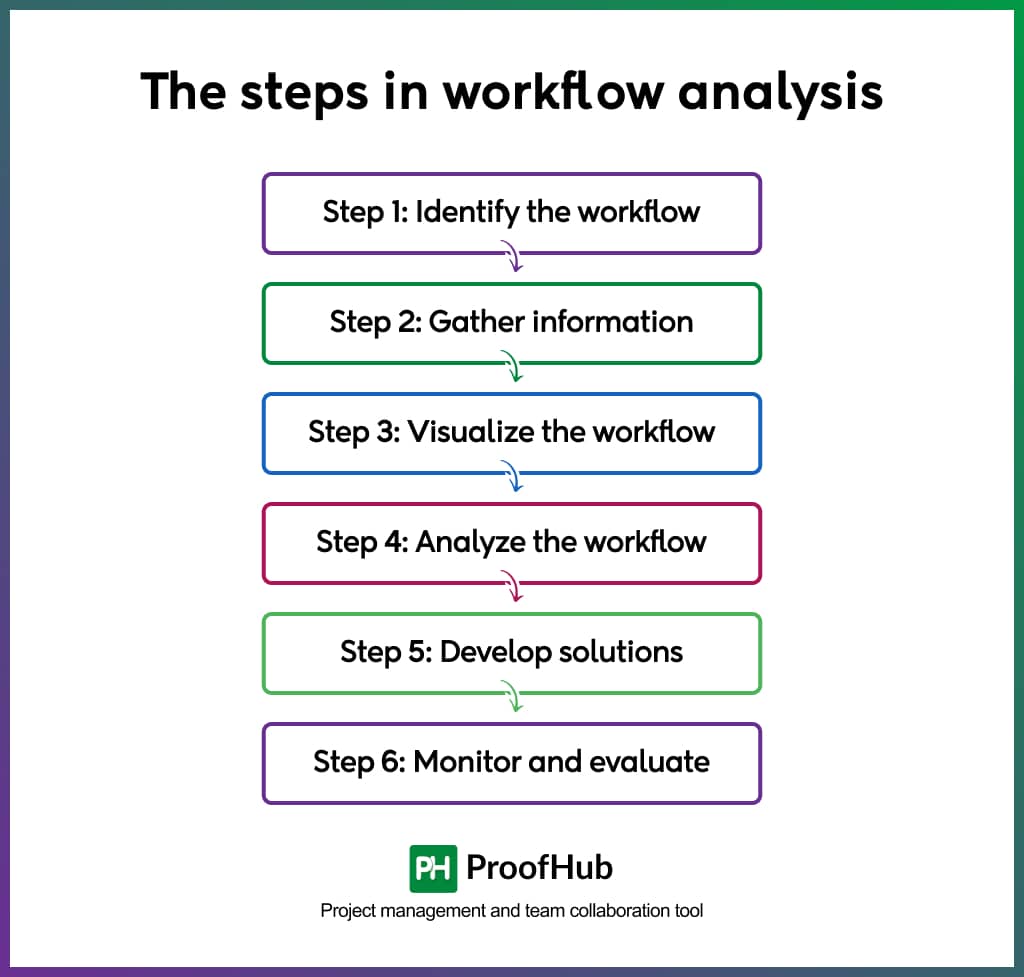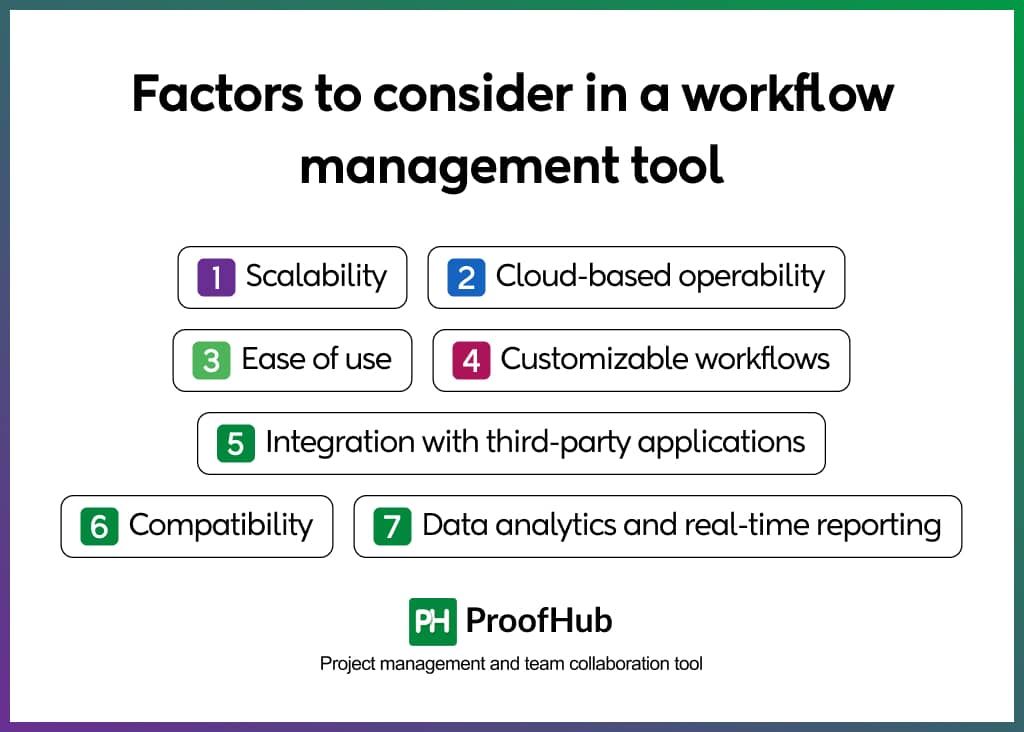Introduction
Have you ever felt that your work processes are taking more time, leading to missed deadlines? You’re not alone. According to a study, Inefficient processes take up 26% of an employee’s productive workday.
Whether you’re managing a small team or handling large projects, understanding the workflow of your organization can help you uncover the inefficiencies in your business.
In this guide, we’ll explore what workflow analysis is, it’s importance, and the steps you can take to improve your business workflows.
What is workflow analysis?
Workflow analysis is a process of evaluating and improving the sequence of tasks, activities, and interactions that make up a particular business process or operation within an organization.
This analysis aims to gain a detailed understanding of how work is performed within an organization, identifying areas where processes can be streamlined, automated, or optimized to achieve better outcomes.
Why workflow analysis is important for businesses?
Now you must be thinking why do companies perform a work-flow analysis and what are the necessities of doing it?
The ultimate goal of performing workflow analysis is to identify inefficiencies, bottlenecks, and areas for improvement in the workflow.
By identifying these issues, companies can work towards streamlining the workflow, eliminating manual processes, and automating a solid workflow. The result is more efficient, productive, and cost-effective business process management.
When performing a workflow analysis, organizations typically assess various aspects of the workflow, such as,
- Process adherence and potential problems
- Time and labor required for tasks
- Rules governing the workflow
- User interactions with tools
- Incidence of errors, delays, miscommunications, and roadblocks
- Fringe cases or unaccounted scenarios
What are the benefits of workflow analysis for businesses?
From resource allocation to better decision-making, analyzing a workflow can benefit you and your team in many more ways.

1. Increased efficiency and productivity
62% of businesses have identified three or more inefficiencies or bottlenecks in their processes that can be solved with effective workflow automation.
Analyzing your workflow enables you to identify these inefficiencies or bottlenecks and streamline processes.
By optimizing the sequence of tasks and eliminating unnecessary steps, teams can work more efficiently, leading to increased productivity.
2. Improved communication and collaboration
Who wants to struggle with miscommunications and lack of collaboration in a team or organization?
If your employees are giving their best, still projects are getting delayed, they only end up getting frustrated.
Workflow analysis can help you understand the flow of information and tasks within a project or department. By doing so, you can identify areas where communication and collaboration may be breaking down.
Once you know where the issues lie, you can make adjustments to your communication processes. You can add team members to relevant distribution lists or invite them to important meetings.
This fosters better communication and collaboration, keeping your team informed about progress.
3. Reduced errors and rework
Through workflow analysis, you can identify potential points of failure in a process and implement preventive measures to minimize errors.
These errors can be anything from simple typos to more complex mistakes that can have serious consequences.
Identifying and addressing these errors early on reduces the need for rework, saving time and resources in the long run.
4. Enhanced decision-making and resource allocation
By analyzing your organization’s workflow, you can gain a better understanding of how everyone is using the provided resources and where there may be problems or inefficiencies.
Armed with this information, you can make informed decisions about resource allocation, ensuring that the right people and tools are available when needed.
5. Increased customer satisfaction
By streamlining workflows and improving efficiency, you can deliver projects on time and with higher quality.
This not only helps deliver projects on time but can also exceed customer expectations, leading to increased satisfaction and potentially fostering long-term client relationships.
What are the different methods for workflow analysis?
Several methods are available that you can use to streamline your business processes. These methods offer different ways to examine, visualize, and assess workflows to recognize areas of inefficiencies and possibilities for enhancement.

1. Time and motion studies
Time and motion studies observe and analyze how employees perform tasks to identify any time-consuming steps.
This method aims to streamline processes and boost efficiency by eliminating unnecessary tasks.
2. Flowcharting
It is a simple visual representation that uses standardized symbols to visually represent the sequence of tasks and decisions in a workflow.
Flowcharting helps you understand process structure, and identify issues, and areas for improvement.
3. Kaizen events
It is a short-term and targeted improvement method that provides a structured framework for teams to address specific issues or inefficiencies in a workflow.
A kaizen event promotes continuous improvement by quickly implementing changes and solutions.
4. Business process mapping
Business process mapping is a detailed form of flowchart that represents relationships between different tasks, subtasks, and resources in a process.
It identifies inefficiencies, redundancies, and opportunities for optimization.
5. Swimlane diagrams
Swimlane diagrams are process maps that organize tasks into different “lanes” based on responsible functions, departments, or roles.
They clarify responsibilities, identify handoffs, and uncover communication or coordination issues.
6. Process mining
This method is based on data that uses event logs like start date or due date to analyze, track, and improve business processes.
It lets you uncover hidden patterns, identify problems, and optimize process performance.
7. Program evaluation and review technique (PERT) chart
PERT chart is a network diagram that analyzes the time it will take to complete each task in a process. It helps you understand all possible workflows and choose the most efficient workflow.
It is useful for planning, scheduling, and optimizing complex projects.
8. Work sampling
Work sampling is a technique that helps you estimate the time spent on different tasks or activities within a workflow.
It identifies patterns, inefficiencies, and improvement opportunities by collecting random samples of work over a period.
What are the steps involved in workflow analysis?
The steps involved in workflow analysis vary depending on the specific needs and goals of the business.
Here is a general six-step plan you can adapt or modify according to your requirements.

Step 1: Identify the workflow
The initial step towards analyzing your workflow is to select a clear and well-defined workflow to focus on.
It can be a specific content creation process, a customer onboarding process, a product development cycle, or even just a part of a larger workflow.
Step 2: Gather information
After selecting a workflow, observe the workflow in action, and review any existing documentation to understand the current state of the workflow. Look for data on cycle times, error rates, and resource utilization.
There is no doubt, you are highly skilled but that doesn’t mean you know everything that’s going on. Ask questions from actual users to understand the pain points, challenges, and opportunities for improvement.
Step 3: Visualize the workflow
Next step is to create a visual representation of the workflow, such as a flowchart or process map. This will help you see the big picture and identify any potential bottlenecks or inefficiencies.
You can also break the workflow down into individual steps or tasks. This will make it easier to analyze and identify areas for improvement.
Step 4: Analyze the workflow
Now that you have an outline of the process, identify any steps or tasks that are slowing down the workflow. These can be tasks that are taking too long, require too much manual effort, or have too many handoffs between different people or teams.
Additionally, you should search for areas where the workflow is not using resources efficiently. Look for any repetitive tasks that your employees are spending their time on unnecessarily. You can automate or eliminate these tasks using a workflow automation tool.
Identify any potential risks associated with the workflow, such as compliance issues or security vulnerabilities.
Step 5: Develop solutions
Once you’ve identified the problems, come up with some potential solutions.
You should understand that not all improvements are equally beneficial. You should prioritize the changes that will have the most significant impact on the workflow’s performance.
Create a plan for implementing your improvements. This should include a timeline, budget, and resources.
Step 6: Monitor and evaluate
After you are done with the modifications, track their impact on the workflow. This will help you determine if you are moving in the right direction and allow you to make any necessary changes.
You should also communicate with the individuals involved in the workflow to get their feedback on the modifications. This will help you identify any unintended consequences and make sure that the improvements are working.
Example of workflow analysis
An effective workflow makes sure that you complete your tasks efficiently. However, to enhance your workflow, you need to analyze it.
For example, let’s take a look at the content creation process. Without a good workflow, content creation can become disorganized and overwhelming.
You may have multiple drafts scattered across different platforms, feedback from other team members in different email threads, and version control can become a mess.
You can identify these issues by analyzing your workflow and can create a more streamlined process by defining clear roles and responsibilities for each team member. Have a centralized location for all drafts and feedback. Also, set up a transparent version control system. This will result in better collaboration, consistent quality, and fewer missed deadlines.
You can also use a workflow management tool to simplify your process. A workflow management tool can help you through the content creation process from start to finish, keeping everything organized and on track.
What tool should you use for workflow management?
According to Gartner, spending on hyper-automation software technologies will exceed $720 billion.
A good workflow automation software like ProofHub allows you to create, optimize, and automate workflows. It offers robust features such as easy task management, real-time collaboration, and streamlined processes.
The main reason businesses go for a workflow management system is to overcome the challenges faced by manual processes, such as human error, delays, and inefficiencies.
What factors to consider in a workflow management tool?
You should use a workflow management tool for your business that adapts to changes, allowing you to manage work efficiently and enhance overall productivity.

There are a few factors that you need to consider in a workflow management tool for managing workflows successfully:
- Scalability: As the business grows, the business requirements also increase proportionally. The tool must be able to scale up to growing business needs.
- Cloud-based operability: Cloud-based workflow management tools allow you to work from anywhere and improve collaboration among team members.
- Ease of use: The tool should be easy to use with a user-friendly interface that requires minimal training for its usage.
- Customizable workflows: Every business has unique workflows. The tool must enable you to create workflows that reflect your business processes and automate tasks.
- Integration with third-party applications: The tool should be able to integrate seamlessly with third-party tools and apps used by businesses in their day-to-day operations. Integration enables uninterrupted data exchange and improves overall business efficiency.
- Compatibility with existing systems: The tool should be compatible with your existing systems and technology infrastructure. It should not require significant changes to be made to your current setup.
- Data analytics and real-time reporting: The tool should enable you to monitor workflow performance and identify areas for improvement. This information can help you make data-driven decisions and optimize your workflows.
Conclusion
Workflow analysis helps you increase productivity, reduce costs, and improve overall business processes. We all have realized the benefits of workflow analysis in work management. The only thing is how effectively we can analyze the process.
With a thorough and effective workflow analysis, organizations can achieve better results, increase efficiency, and ensure timely delivery of projects. Tools like ProofHub play a crucial role in this process by providing comprehensive features for visualizing, tracking, and optimizing workflows.
I hope the above guide provides you with all the information you need to analyze your business processes and improve workflow.
Related articles
- Workflow management system: Key features, benefits, & examples
- Mastering workflow management: Systems, best practices & challenges
- What is workflow automation: A detailed guide
FAQs
What is a key output of workflow analysis?
Workflow analysis provides a comprehensive understanding of processes, identifying inefficiencies, bottlenecks, and areas for improvement. This leads to optimized workflows and enhanced organizational efficiency.
What are the common challenges in workflow analysis?
When analyzing workflows, common challenges that you may face are identifying bottlenecks, comprehending complex processes, obtaining accurate data, adapting to changes, ensuring stakeholder collaboration, and selecting appropriate analysis tools.
How often should a workflow analysis be conducted?
You should conduct a workflow analysis regularly, typically annually, or whenever significant changes occur. The frequency ensures that processes remain efficient, adaptable, and aligned with organizational goals and industry standards.
What are the elements of workflow analysis?
There are a few key elements that you need to consider for conducting a thorough and effective workflow analysis.
1. Create a clear step-by-step guide
Outline each step required to complete your workflow from start to finish. Create a visual decision tree to easily visualize the process.
2. Estimate the time needed for each step
Assess how much time you need to complete each task. Compare these calculations with the actual time each task takes. If time data is not available, start recording to track the duration of each step accurately.
3. Evaluate the cost of each step
Analyze the total cost of each step in your workflow, including all materials and labor expenses. Is the cost unexpectedly high for the value of the task?
4. Remove redundancies
Identify and remove any step that does not contribute significantly to your end goal or that repeats the efforts of any other steps unnecessarily.
5. Optimize the workflow
Transform and automate parts of your workflow to enhance efficiency. Recognize bottlenecks and implement innovative systems to streamline processes.
What are the different types of workflow analysis?
There are three types of workflow analysis: linear, cross-functional, and hybrid. Linear analyses processes step by step, cross-functional involves multiple departments within an organization, and hybrid combines elements of both.

